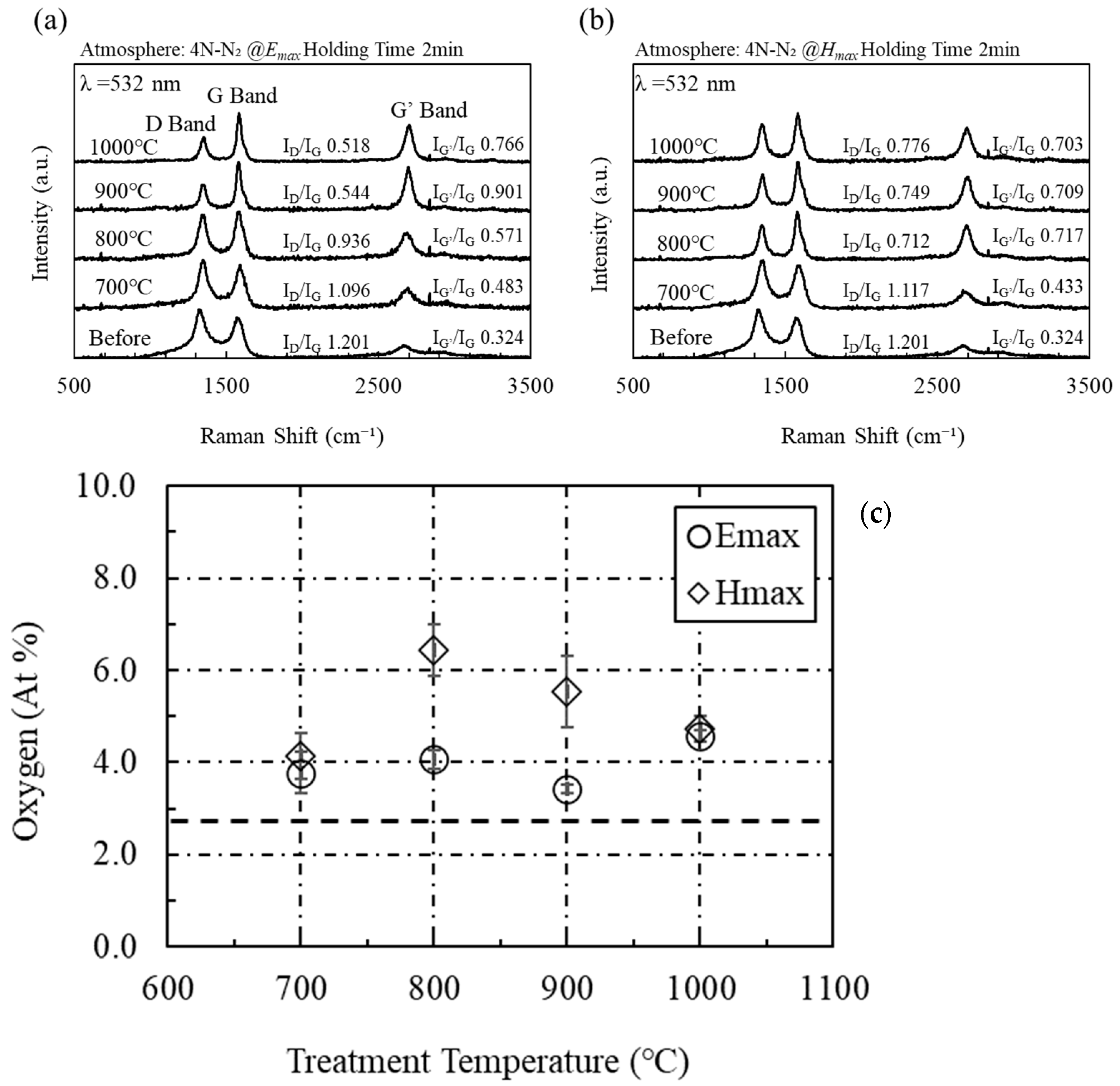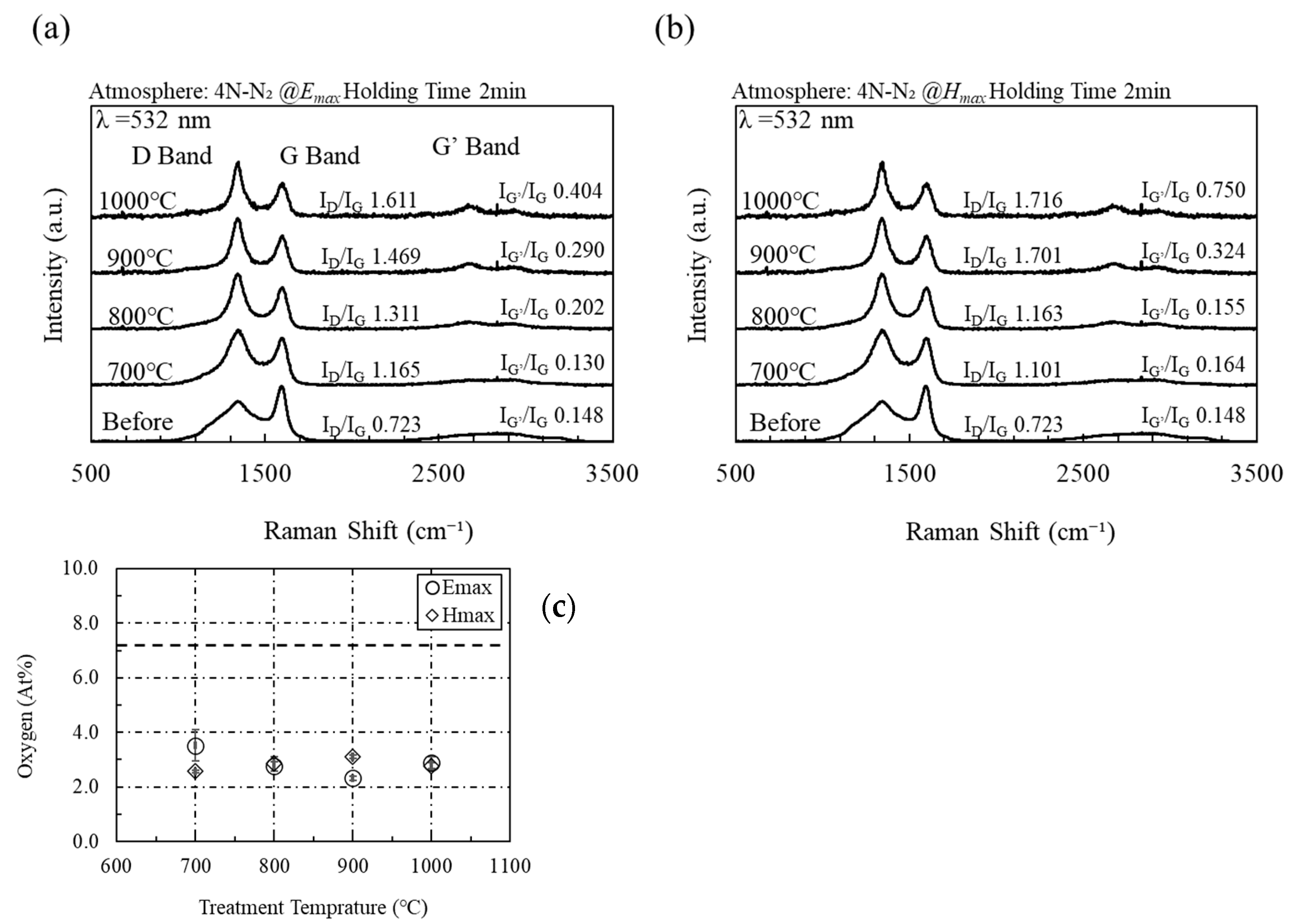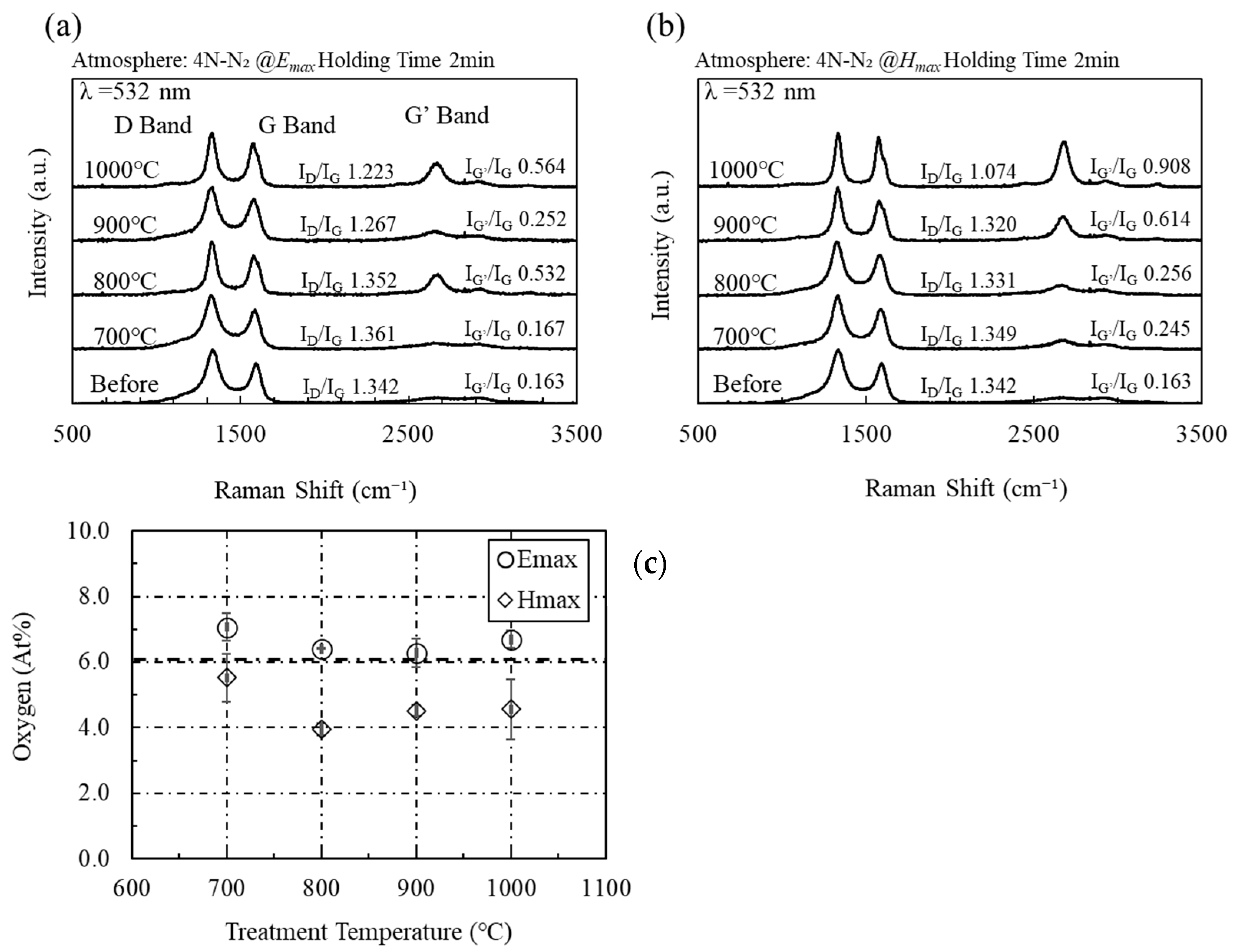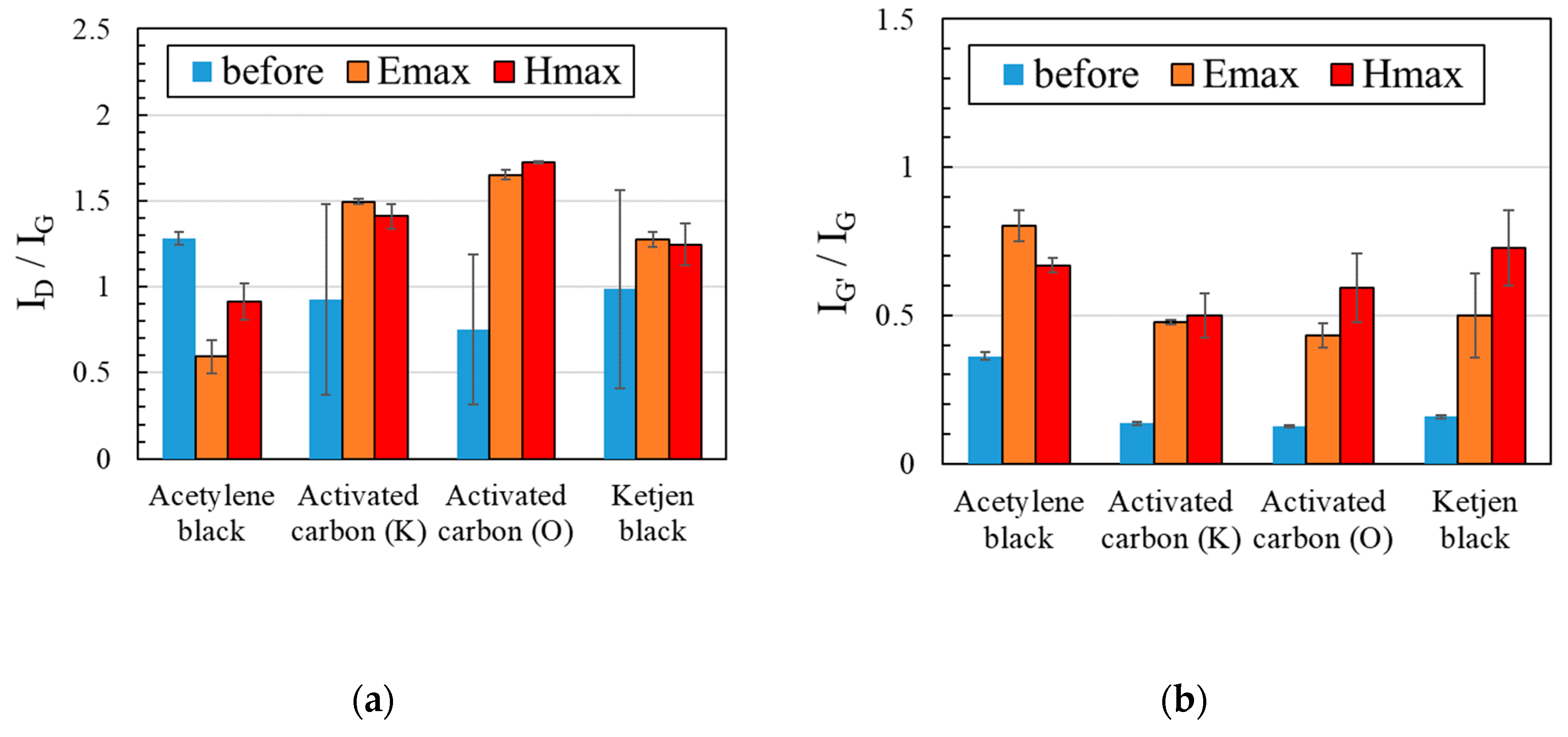Synthesis of Graphene-like Materials from Acetylene Black, Activated Carbon, and Ketjenblack via Separated Microwave Electric and Magnetic Field Heating
Abstract
1. Introduction
2. Materials and Methods
3. Results
4. Conclusions
- (1)
- In acetylene black, activated carbon, and Ketjenblack, microwave heating was more effective for defect repair and crystallization than electric furnace heating. Defect repair and increased π bonding were observed as the microwave irradiation temperature increased.
- (2)
- The number of oxygen atoms adhering to the activated carbon surface was reduced during microwave heating. Defect repair by microwave heating in activated carbon is inferior to that in acetylene black.
- (3)
- Microwave-heated acetylene black, activated carbon, and Ketjenblack had a region where the temperature is approximately 200 °C higher than those of the surrounding regions, and the magnitude tended to differ depending on the electric and magnetic fields.
- (4)
- Acetylene black is a promising raw material for graphene synthesis via microwave heating.
Supplementary Materials
Author Contributions
Funding
Institutional Review Board Statement
Informed Consent Statement
Data Availability Statement
Acknowledgments
Conflicts of Interest
References
- Kroto, H.W.; Heath, J.R.; O’Brien, S.C.; Curl, R.F.; Smalley, R.E. C60: Buckminsterfullerene. Nature 1985, 318, 162–163. [Google Scholar] [CrossRef]
- Iijima, S. Helical microtubules of graphitic carbon. Nature 1991, 354, 56–58. [Google Scholar] [CrossRef]
- Yuge, R.; Nihey, F.; Toyama, K.; Yudasaka, M. Preparation and characterization of newly discovered fibrous aggregates of single-walled carbon nanohorns. Adv. Mater. 2016, 28, 7174–7177. [Google Scholar] [CrossRef] [PubMed]
- Sugden, B. Synthesis for a complex role. Nature 1989, 339, 179–180. [Google Scholar] [CrossRef]
- Weller, T.E.; Ellerby, M.; Saxena, S.S.; Smith, R.P.; Skipper, N.T. Superconductivity in the intercalated graphite compounds C6Yb and C6Ca. Nat. Phys. 2005, 1, 39–41. [Google Scholar] [CrossRef]
- Lee, C.; Wei, X.; Kysar, J.W.; Hone, J. Measurement of the elastic properties and intrinsic strength of monolayer graphene. Science 2008, 321, 385–388. [Google Scholar] [CrossRef]
- Balandin, A.A.; Ghosh, S.; Bao, W.; Calizo, I.; Teweldebrhan, D.; Miao, F.; Lau, C.N. Superior thermal conductivity of single-layer graphene. Nano Lett. 2008, 8, 902–907. [Google Scholar] [CrossRef]
- Novoselov, K.S.; Geim, A.K.; Morozov, S.V.; Jiang, D.; Zhang, Y.; Dubonos, S.V.; Grigorieva, I.V.; Firsov, A.A. Electric field effect in atomically thin carbon films. Science 2004, 306, 666–669. [Google Scholar] [CrossRef]
- Yang, Y.; Asiri, A.M.; Tang, Z.; Du, D.; Lin, Y. Graphene based materials for biomedical applications. Mater. Today 2013, 16, 365–373. [Google Scholar] [CrossRef]
- Xu, Z.; Gao, C. Graphene fiber: A new trend in carbon fibers. Mater. Today 2015, 18, 480–492. [Google Scholar] [CrossRef]
- Li, X.; Cai, W.; An, J.; Kim, S.; Nah, J.; Yang, D.; Piner, R.; Velamakanni, A.; Jung, I.; Tutuc, E.; et al. Large-area synthesis of high-quality and uniform graphene films on copper foils. Science 2009, 324, 1312–1314. [Google Scholar] [CrossRef]
- Sutter, P.W.; Flege, J.-I.; Sutter, E.A. Epitaxial graphene on ruthenium. Nat. Mater. 2008, 7, 406–411. [Google Scholar] [CrossRef]
- Pei, S.; Zhao, J.; Du, J.; Ren, W.; Cheng, H.-M. Direct reduction of graphene oxide films into highly conductive and flexible graphene films by hydrohalic acids. Carbon 2010, 48, 4466–4474. [Google Scholar] [CrossRef]
- Li, Y.; Chen, Q.; Xu, K.; Kaneko, T.; Hatakeyama, R. Synthesis of graphene nanosheets from petroleum asphalt by pulsed arc discharge in water. Chem. Eng. J. 2013, 215–216, 45–49. [Google Scholar] [CrossRef]
- Chakrabarti, A.; Lu, J.; Skrabutenas, J.C.; Xu, T.; Xiao, Z.; Maguire, J.A.; Hosmane, N.S. Conversion of carbon dioxide to few-layer graphene. J. Mater. Chem. 2011, 21, 9491–9493. [Google Scholar] [CrossRef]
- Akhavan, O.; Bijanzad, K.; Mirsepah, A. Synthesis of graphene from natural and industrial carbonaceous wastes. RSC Adv. 2014, 4, 20441–20448. [Google Scholar] [CrossRef]
- Luong, D.X.; Bets, K.V.; Algozeeb, W.A.; Stanford, M.G.; Kittrell, C.; Chen, W.; Salvatierra, R.V.; Ren, M.; McHugh, E.A.; Advincula, P.A.; et al. Gram-scale bottom-up flash graphene synthesis. Nature 2020, 577, 647–651. [Google Scholar] [CrossRef]
- Islam, A.; Mukherjee, B.; Pandey, K.K.; Keshri, A.K. Ultra-Fast, Chemical-Free, Mass Production of High Quality Exfoliated Graphene. ACS Nano 2021, 15, 1775–1784. [Google Scholar] [CrossRef]
- Voiry, D.; Yang, J.; Kupferberg, J.; Fullon, R.; Lee, C.; Jeong, H.Y.; Shin, H.S.; Chhowalla, M. High-quality graphene via microwave reduction of solution-exfoliated graphene oxide. Science 2016, 353, 1413–1416. [Google Scholar] [CrossRef]
- Li, Z.; Yao, Y.; Lin, Z.; Moon, K.S.; Lin, W.; Wong, C. Ultrafast, dry microwave synthesis of graphene sheets. J. Mater. Chem. 2010, 20, 4781–4783. [Google Scholar] [CrossRef]
- Wong, C.H.A.; Jankovský, O.; Sofer, Z.; Pumera, M. Vacuum-assisted microwave reduction/exfoliation of graphite oxide and the influence of precursor graphite oxide. Carbon 2014, 77, 508–517. [Google Scholar] [CrossRef]
- Jiang, W.S.; Yang, C.; Chen, G.X.; Yan, X.Q.; Chen, S.N.; Su, B.W.; Liu, Z.B.; Tian, J.G. Preparation of high-quality graphene using triggered microwave reduction under an air atmosphere. J. Mater. Chem. C 2018, 6, 1829–1835. [Google Scholar] [CrossRef]
- Miyata, T.; Gohda, S.; Fujii, T.; Ono, H.; Itoh, H.; Nishina, Y.; Kashimura, K. Pure electric and magnetic fields applied to reduced graphene oxide for defect repair and oxygen removal. Carbon 2021, 171, 10–15. [Google Scholar] [CrossRef]
- Roy, R.; Peelamedu, R.; Hurtt, L.; Cheng, J.; Agrawal, D. Definitive experimental evidence for Microwave Effects: Radically new effects of separated E and H fields, such as decrystallization of oxides in seconds. Mater. Res. Innov. 2002, 6, 128–140. [Google Scholar] [CrossRef]
- Sugawara, H.; Kashimura, K.; Hayashi, M.; Ishihara, S.; Mitani, T.; Shinohara, N. Behavior of microwave-heated silicon carbide particles at frequencies of 2.0–13.5 GHz. Appl. Phys. Lett. 2014, 105, 034103. [Google Scholar] [CrossRef]
- Ogura, T.; Matsumoto, T.; Miwa, S.; Mori, M.; Hibiki, T. Experimental study on molten metal spreading and deposition behaviors. Ann. Nucl. Energy 2018, 118, 353–362. [Google Scholar] [CrossRef]
- Kaniyoor, A.; Ramaprabhu, S. A Raman spectroscopic investigation of graphite oxide derived grapheme. AIP Adv. 2012, 2, 032183. [Google Scholar] [CrossRef]
- Kondrashov, V.A.; Struchkov, N.S.; Rozanov, R.Y.; Nevolin, V.K.; Kopylova, D.S.; Nasibulin, A.G. Graphene oxide reduction by solid-state laser irradiation for bolometric applications. Nanotechnology 2017, 29, 035301. [Google Scholar] [CrossRef]
- Malard, L.M.; Pimenta, M.A.; Dresselhaus, G.; Dresselhaus, M.S. Raman spectroscopy in grapheme. Phys. Rep. 2009, 473, 51–87. [Google Scholar] [CrossRef]
- Ferrari, A.C.; Meyer, J.C.; Scardaci, V.; Casiraghi, C.; Lazzeri, M.; Mauri, F.; Piscanec, S.; Jiang, D.; Novoselov, K.S.; Roth, S.; et al. Raman spectrum of graphene and graphene layers. Phys. Rev. Lett. 2006, 97, 187401. [Google Scholar] [CrossRef]
- Yang, G.; Li, L.; Lee, W.B.; Ng, M.C. Structure of graphene and its disorders: A review. Sci. Technol. Adv. Mater. 2018, 19, 613–648. [Google Scholar] [CrossRef]
- Kashimura, K.; Hasegawa, N.; Suzuki, S.; Hayashi, M.; Mitani, T.; Nagata, K.; Shinohara, N. Microwave Heating Behavior of Conductive Multi-particles using Spatially Separated Electric and Magnetic nodes-Effects of Relative Density on Absorption Properties of Various Carbon Powder Compacts. J. Appl. Phys. 2013, 113, 024902. [Google Scholar] [CrossRef]
- Chase, M.W. NIST-JANAF Thermochemical Tables, 4th ed.; Journal of Physical and Chemical Reference Data; American Institute of Physics: College Park, MD, USA, 1998; pp. e641–e643. [Google Scholar]
- Hayashi, M.; Takeda, K.; Kashimura, K.; Watanabe, T.; Nagata, K. Carbothermic reduction of hematite powders by microwave heating. ISIJ Int. 2013, 53, 1125–1130. [Google Scholar] [CrossRef]









Disclaimer/Publisher’s Note: The statements, opinions and data contained in all publications are solely those of the individual author(s) and contributor(s) and not of MDPI and/or the editor(s). MDPI and/or the editor(s) disclaim responsibility for any injury to people or property resulting from any ideas, methods, instructions or products referred to in the content. |
© 2023 by the authors. Licensee MDPI, Basel, Switzerland. This article is an open access article distributed under the terms and conditions of the Creative Commons Attribution (CC BY) license (https://creativecommons.org/licenses/by/4.0/).
Share and Cite
Miyata, T.; Gohda, S.; Oshita, A.; Ono, H.; Kashimura, K. Synthesis of Graphene-like Materials from Acetylene Black, Activated Carbon, and Ketjenblack via Separated Microwave Electric and Magnetic Field Heating. Materials 2023, 16, 3723. https://doi.org/10.3390/ma16103723
Miyata T, Gohda S, Oshita A, Ono H, Kashimura K. Synthesis of Graphene-like Materials from Acetylene Black, Activated Carbon, and Ketjenblack via Separated Microwave Electric and Magnetic Field Heating. Materials. 2023; 16(10):3723. https://doi.org/10.3390/ma16103723
Chicago/Turabian StyleMiyata, Takeshi, Syun Gohda, Akio Oshita, Hironobu Ono, and Keiichiro Kashimura. 2023. "Synthesis of Graphene-like Materials from Acetylene Black, Activated Carbon, and Ketjenblack via Separated Microwave Electric and Magnetic Field Heating" Materials 16, no. 10: 3723. https://doi.org/10.3390/ma16103723
APA StyleMiyata, T., Gohda, S., Oshita, A., Ono, H., & Kashimura, K. (2023). Synthesis of Graphene-like Materials from Acetylene Black, Activated Carbon, and Ketjenblack via Separated Microwave Electric and Magnetic Field Heating. Materials, 16(10), 3723. https://doi.org/10.3390/ma16103723





